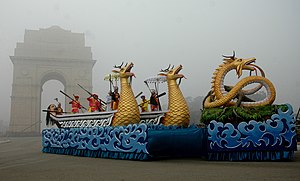
Back Nongthang Leima English Nongthang Leima HIF ꯅꯣꯡꯊꯥꯡ ꯂꯩꯃ MNI நோங்தாங் லீமா Tamil Нонгтанг Лейма Ukrainian نونگ تھینگ لیما Urdu
| Nongthang Leima | |
|---|---|
Goddess of enchantment, seduction, thunder and lightning | |
| Member of Lairembis | |
 | |
| Other names |
|
| Meitei | |
| Affiliation | Meitei mythology (Manipuri mythology) and Meitei religion (Sanamahism) |
| Abode | Heaven |
| Symbols | thunder and lightning |
| Texts | Leithak Leikharol |
| Gender | Female |
| Region | Ancient Kangleipak (Antique Manipur) |
| Ethnic group | Meitei ethnicity |
| Festivals | Lai Haraoba |
| Personal information | |
| Consorts | Sanamahi and Pakhangba[1] |
| Offspring | Laisang Khekwaiba (with Sanamahi) |
| Parents | |
| Siblings | Sanamahi and Pakhangba |
| Greek equivalent | Astrape and Bronte |
| Roman equivalent | Fulgora |
Nongthang Leima (Meitei: ꯅꯣꯡꯊꯥꯡ ꯂꯩꯃ) is the goddess of seduction, thunder and lightning in Meitei mythology and religion.[2][3][4][5] She was created by Atingkok (or Salailen) to attract Haraba (Pakhangba).[4][6][7] She mastered thunder and lightning in the chaos in the early world. She predicted the first rain.[8] She limits the chaos and helps creation.[9]
- ↑ Ray, Asok Kumar; Chakraborty, Satyabrata (2008). Society, Politics, and Development in North East India: Essays in Memory of Dr. Basudeb Datta Ray. Concept Publishing Company. p. 79. ISBN 978-81-8069-572-8.
- ↑ Singh, L. Bhagyachandra (1991). A Critical Study Of The Religious Philosophy. p. 51.
- ↑ Moirangthem Kirti (1993). Folk Culture of Manipur. Manas Publications. ISBN 978-81-7049-063-0.
- ↑ 4.0 4.1 Folk-lore. Indian Publications. 1991.
- ↑ The Anthropologist: International Journal of Contemporary and Applied Studies of Man. Kamla-Raj Enterprises. 2003.
- ↑ Session, North East India History Association (1995). Proceedings of North East India History Association. The Association.
- ↑ "Incarnations of Goddess Nongthang Leima By James Oinam". www.e-pao.net. Retrieved 2022-03-15.
- ↑ Koenraad Elst (2002). Who is a Hindu? Hindu Revivalist Views of Animism, Buddhism, Sikhism and Other Offshoots of Hinduism. p. 165.
- ↑ Rao, Nitya; Rürup, Luise (1997). A Just Right: Women's Ownership of Natural Resources and Livelihood Security. Friedrich Ebert Stiftung. p. 175. ISBN 978-81-7440-044-4.
